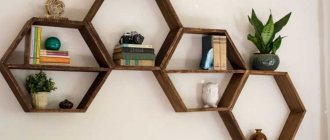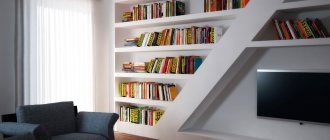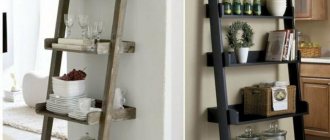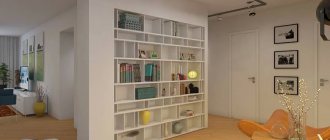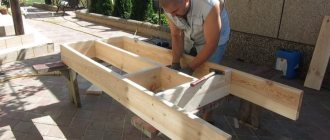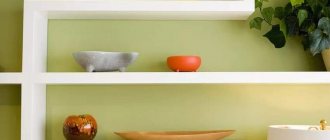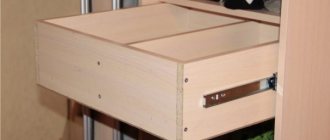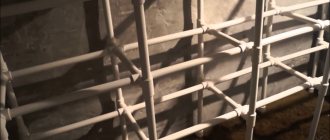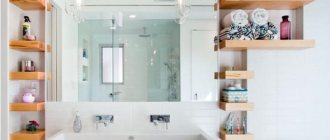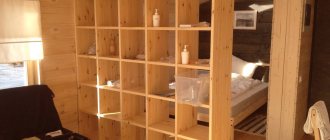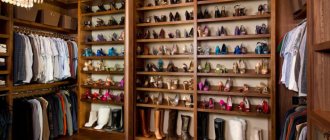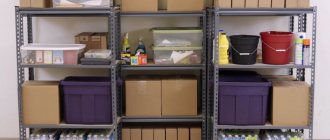A corner shelf on the wall successfully copes with the task of saving space. It is relevant in any room, be it a kitchen, hallway, living room or bathroom. The choice of manufacturing material depends on the operating conditions and the prevailing style in the interior.
The variety of design solutions allows you to choose the optimal size and shape of the corner shelf. If among the rich assortment of finished products there is no suitable specimen, a do-it-yourself corner shelf will become a worthy element of the interior.
Material of manufacture
The choice of material for shelves on the wall takes into account three factors. Initially, the operating conditions of corner structures are assessed. The design of the room plays a significant role. The purpose of installing the shelf is also important: will there be light souvenirs and trinkets on it, or will the structure be intended for a large number of heavy books. After analyzing all the components, they come to the final choice.
Characteristics of materials used in the production of corner shelves on the wall:
- Natural wood. Wooden specimens look aesthetically pleasing. Due to their high cost, natural woods are used infrequently, provided the furnishings of the room are appropriate. Products with hand carvings are particularly exquisite. Originality is inherent in shelves on the wall made of untreated wood, which will suit the interior of a kitchen with a rustic style.
- Much more often, corner shelves are made of MDF and chipboard. This material is affordable and easy to process, so it is most in demand when making wall structures yourself.
- Plasterboard sheets and gypsum plasterboard. Corner shelves made of plasterboard are used under conditions of light load. If you plan to install the structure on the kitchen wall, where contact with water is possible, it is recommended to take moisture-resistant gypsum fiber board.
- Plastic. Ideal as a base for a corner shelf in a bathroom. Key advantages are stability in conditions of high humidity and affordable price. The low strength of plastic does not play a significant role when storing small hygiene items.
- Glass. The visual airiness of glass is in demand in modern interiors, where laconicism and lack of clutter are valued. The glass design element will fit perfectly into the interior of the bathroom and living room. It is better to avoid using a corner glass shelf on the wall of the kitchen and hallway.
- Metal. When making shelves for the interior of a living space, it is rare. The advantages of the material are its particular strength, but this quality is rarely in demand for storing household utensils. The combined design looks extraordinary when the glass shelf is complemented by a forged holder. Much more often you can see corner structures on the wall, where multi-tiered shelves made of chipboard are interconnected by metal support posts. The deliberate roughness of the loft style will be organically perceived by the corner shelf, where the frame is an intricate structure made of pipes.
As you can see, there are many practical and original solutions for what material to choose for a wall structure. Corner shelves in the interior in the photo below:
Corner shelf options
Finding a practical use for any shelves is not at all difficult, because in every home there are things that need to be organized. The area of the room does not always allow for a sufficient number of storage systems. In a small apartment, every centimeter of space is valuable and the owners try to make all corners of their home as functional as possible. Light and at the same time spacious corner shelves will help not to overload the room.
The attractiveness of corner shelves depends on the chosen material, the originality of the design and additional accessories.
For books
A corner shelf as a book storage rack is not very convenient, but it is a pretty good option for a small room in which it is difficult to place a full-fledged bookcase. A small corner library will be good for a child’s room, since a child usually does not have as many books as in the parent’s bookcase.
The dimensions of the corner shelf should correspond to what will be stored on it
It is advisable to store books in closed cabinets so that they do not become covered with dust, otherwise you will have to vacuum your library quite often.
For storing accessories
If the shelf is used for accessories, the sole purpose of which is to decorate the interior, then on each of its compartments it is better to place either one independent decorative item or several, complementary and made in the same style. These can be figurines, vases, candles, photographs in frames, flower pots.
You can make a neat shelf for accessories with your own hands from plywood.
And others
In the kitchen, an open corner shelving unit can be used to place tea and coffee utensils in beautiful ceramic or tin cans, containers with spices and other frequently used kitchen utensils.
Wooden shelves fit perfectly into the kitchen interior, made in Scandinavian, Provence or country style
In the children's room, your favorite toys will be conveniently placed on a shelf in the corner. It’s good if one of the compartments is closed - it’s convenient for a girl to store hairpins, rubber bands, bows, and for a boy - small toys, various collections that often create a mess in the room, but children really love to collect them.
Plastic corner shelves with sides in a child's room
In a nursery, for safety reasons, it is not advisable to use a hanging rack for toys or books; a child may inadvertently tear off the shelf and be injured. For reliable stability, it is better to additionally attach a rack standing on the floor to the wall, then no matter what games the children come up with, they will not be able to knock over the furniture on themselves.
Design features and methods of fastening
There are many ways to design corner structures on the wall. The most common models are designed for internal corners.
Comment! A design with an external corner requires an individual approach to the manufacture of shelves. This option is appropriate in spacious rooms.
Corner wall mounted shelves amaze with their variety of designs. Simplicity and conciseness are inherent in specimens where one or several small shelves with a rounded edge occupy only a corner. Models that spread out to the sides along the walls look much more interesting. They can be symmetrical or of different sizes, complemented by side walls or remain minimalist. An example of corner shelves on the wall in the photo:
In addition to wall structures, there are other practical ways to decorate the interior. A corner shelving unit with open shelves is a functional solution for storing a large number of books or things.
There are multi-tiered models of whatnot type. You are unlikely to achieve space savings with such an interior element, but there is an exclusive design.
The method of wall mounting is chosen taking into account the design of the corner shelf. Small single-level models are fixed with hinges; metal corners are suitable for multi-tiered products. Brackets are used when attaching shelves intended for heavy objects to the wall. Glass shelves on forged stands look nontrivial. Hidden fastenings will add glamor to the interior, making the shelf seem to float in the air.
Creative individuals who value a non-standard approach to solving common problems will like ideas where belts or chains supplemented with anchor bolts are used to fix shelves to the wall.
Corner shelf in the hallway: which design to choose
When decorating the interior of a hallway in an apartment or private house, special attention must be paid to the distribution of space. Such premises are most often not large in size, so they require proper arrangement. Each piece of furniture located in the hallway should be as functional as possible.
In this case, corner structures are indispensable. Many models of such shelves are not only compact, but also quite spacious. The advantages of corner products also include ease of self-assembly, long service life and ease of cleaning.
Note! When choosing suitable shelves for the corridor, you need to focus on the amount of free space, the decor of the room and the cost of the products. The price of such structures varies depending on the material from which they are made, the design, as well as what fasteners are required for their installation.
The most common option used for installation in the hallway are shelves made of chipboard. It is recommended to purchase laminated products, as they have higher technical characteristics and, accordingly, a longer service life.
Even if the shelf in the living room is made in a minimalist style, it will still look quite attractive
The cost of corner multi-tiered structures used for hallways varies from 2 to 5 thousand rubles. The height of such shelves may vary. The most common are models in which this figure is 180-190 cm.
For a more rational use of the useful space of a small corridor, it is recommended to purchase a shelf equipped with a door with a mirror surface. Before buying this piece of furniture, it is recommended to study the photo of the corner shelves. This will allow you to choose the desired design and color.
Corner shelves of this type can be either wall-mounted or floor-mounted. As for the design of these structures, they have different colors. Their surface can be matte or glossy. The texture is selected depending on the individual preferences of the owners. It is worth noting that glossy products are easier to clean from dust and dirt.
Corner shelves made of chipboard are the most common and advantageous option for the hallway
Kitchen
A large number of small items that should always be at hand will fit perfectly on a compact wall structure. Wooden products are practical. This could be a rough model of a “floating” shelf or a more sophisticated one. The design depends on the overall style of the room. Metal, glass and plastic are rarely used in the kitchen. When making shelves on the wall yourself, it is possible to use GVL.
If in a compact area shelves often perform a practical function, then in spacious interiors they are given a more decorative role. Beautiful cups or small figurines will be a wonderful addition to the decor. Look at the photo how impressive the shelf looks, the outline of which follows the shape of the corner cabinet:
Interesting wooden shelf. Master Class
You will need:
- Rope;
- Board at least 2 cm thick;
- 2 corners (mounts) for shelves;
- Steel washers;
- Lighter;
- Drill;
- Saw.
Today, even the most modern and fashionable designer does not take advantage of the opportunity to use practical and stylish shelves when decorating the interior. They will not only become an integral part of the future decor, but will also serve as an excellent stand for books (mount for bookshelves), for photos and decorative items.
There are two types of shelf mounting available:
- standard method (using hinged brackets, corners, etc.);
- fastening shelves to the wall without visible fasteners.
We will look at the first method in more detail, since with the standard design it is difficult to achieve a combination of the future interior with the target design.
- Preparation for fastening
- Detailed mounting instructions with photos
Let's consider the process of preparing the fastening
- First of all, you will need to assess how reliable the wall is where our shelf will be mounted. If it is a brick wall, then it should be at least 25 cm thick, and if you have a concrete wall, then from 10 cm, which will allow you to place not only decorative elements on the shelves.
1 – fastening element;
2 – holes for installation;
3 – metal rod;
4 – hinged bracket;
5 – shelf.
2. After this, we move on to determining the thickness of the future shelf.
To do this, you must know exactly what will be placed on the shelf so that there is no deflection or deformation. You can check this simply by taking a board of approximate thickness and placing a weight on it.
- If the interior concept requires thicker boards, then in this case everything should be used according to the recommendations of your designer or the chosen style.
- You will need to take into account the mounting features, since the thickness of the shelf cannot be less than 3 cm. If books are placed, it is better to use a thickness of 4.5 to 6 cm.
- The future shelf will need to be thoroughly dried and soaked before processing.
How to install shelves to a wall without visible fasteners
Step 1. Measure the distance between the holes.
Step 3. After this, we apply our fastening element to the resulting axis and mark holes for it, which should be located on a horizontal line.
Step 5. After this, we clean all the holes from any remaining shavings and dust and drive wooden pegs or plugs under the dowels.
Step 6. After this, take dowels or screws and screw the fastening element to the plugs or pegs.
Step 7. After this, we proceed to installing the shelf itself on the fasteners. If the shelf does not fit very tightly, you can tap it with your palm or a rubber hammer to securely fix it. It should be noted that you need to knock alternately on the left and right, this way you will prevent the shelf from skewing and it will sit evenly on the fastening element.
The problem of free space is always relevant, especially for small apartments. What to do if you want to place your favorite books or children's crafts? Corner shelves will help out.
Almost always in the apartment there is an unoccupied free corner in which a rack or small shelf would be perfectly located. This will free up some space and also add a new decorative element.
Hallway
You can show a creative approach when decorating the interior with a corner shelf in the hallway. There are many options for using the design:
- A small shelf on the wall is used to store keys.
- A completely different modification is needed for bags.
- Floor structures reminiscent of bookcases look elegant in a spacious hallway. Usually they are filled with souvenirs and other decorative elements.
- A corner wooden wall shelf can serve as a hanger.
Advice! A corner shoe stand will look harmonious in tandem.
As in the case of the kitchen, products made from wood or its derivatives are optimal for the hallway. The shape and dimensions are chosen based on the area of the room. Corner shelves in the hallway in the photo below:
Shelf for iconostasis
According to tradition, such a single-tier shelf is placed in the eastern corner of the house. To make it, a solid wood or wide board is selected.
If the corner shelf for icons is not decorated with carvings, then the process of its manufacture is no different from a shelf for the living room. But unlike it, a cornice in the form of a narrow strip should be installed on the front part. It is often made curly.
The cornice is secured to the shelf with dowels (wooden pins). Holes are drilled under them in a triangle with a depth of 2-3 cm. After installation, they should protrude outward by 1 cm. After drilling holes on the cornice, it is secured to the dowels using glue.
Bathroom
It’s hard to imagine a bathroom interior without a corner shelf on the wall. This is the optimal solution for storing a large number of cosmetics. It is inconvenient to place jars and tubes in cabinets that should always be at hand.
There are two main manufacturing options - glass combined with a chrome stand or plastic with a metal stand. There is not such a variety of models as in the kitchen and hallway for the bathroom. The laconic design is caused by special operating conditions. Regular contact with water or simply high humidity provokes rapid contamination of the surface. It is the simple outlines that will help you keep the corner shelf on the wall clean and not spend a lot of time on maintenance.
Advice! It is not advisable to make a shelf on the bathroom wall with your own hands.
Manufacturers offer a wide range of functional ready-made specimens, which are equipped with all kinds of hooks for washcloths, special soap dishes and have perforations for water drainage.
Desk with corner shelves: a rational solution for the room
A design of this type is perfect for setting up a work area in an apartment. A table equipped with corner shelves does not require much space, but it is enough to accommodate all the necessary items.
For ease of work, a corner table requires mandatory lighting. The dimensions of the table, chair, and shelves are selected depending on several factors. It is very important that the shelves are within easy reach. This will allow you to organize a convenient place where it will be pleasant to work.
Corner wall mounted shelves in this case can have a variety of shapes. Products are made with rounded edges, in the shape of the letter “L” or have a triangle design.
Modern computer desks have more compact dimensions than their predecessors. This allows you to choose the necessary design even when there is not much free space in the room.
One of the main features of a corner shelf above a desk is that it is within easy reach of the user
When choosing the number of shelves, you need to focus on what items will be stored on them. Taking this factor into account, you can choose a multi-tier structure or a table equipped with just one corner shelf.
Note! The functionality of such structures is the determining factor in their selection. While the upper surface of the product will be used as a support for various items, spotlights can be placed on the lower part of the shelf.
Living room
Shelves on the living room wall are an indispensable piece of furniture. The range of their use is very wide. Reading lovers will benefit from a spacious corner shelving unit with open shelves. Wall shelves, the size and configuration of which are selected taking into account their purpose, will save free space. A large number of books requires the installation of a three-dimensional structure on the wall. In this case, the reliability of the fastening deserves attention. If a functional piece of furniture serves as a stand for decorative elements, opt for more compact models.
Often icons are placed on small corner shelves. Particularly exquisite are the pieces with carvings and figured wooden details.
Wall-mounted models designed for indoor plants are no less popular. Depending on the situation, choose elegant metal or wooden products.
Corner glass shelves are less common in the living room interior; they are mainly intended for displaying small souvenirs, photo frames and figurines. To maintain an atmosphere of lightness in the interior, you should not place a large number of things on an open corner shelf, so as not to create the effect of disorder or clutter.
Plasterboard structures on the outer corners of walls look extremely aesthetically pleasing. Owners of spacious interiors can afford such luxury. For compact housing, it is important to use LED lighting, which will become an inexpensive and attractive design element.
Corner Wall Wooden Shelves for Kitchen
Open shelves have many advantages compared to cabinets that are installed in the kitchen. Firstly, less space is required to accommodate such a structure. Secondly, a correctly selected shelf allows you to visually expand the space of the room. This is especially true for small kitchens.
Another advantage of an open corner shelf is that all kitchen utensils located on it are in the owner’s field of view. On such structures you can place items that are used most often.
Thanks to the use of wall shelves when decorating the kitchen interior, the room takes on a complete look.
Note! Corner designs are an excellent complement to wall-mounted wooden kitchen cabinets.
This type of furniture, in addition to its undeniable advantages, also has some disadvantages. For example, dishes placed on open shelves quickly become covered with a layer of dust. Most often, such products have compact dimensions, so they are not suitable for storing large pots and pans.
In some cases, owners do not want kitchen utensils to be placed in plain sight. In such situations, it is recommended to install closed cabinets with shelves. Photos of corner structures will allow you to evaluate their advantages and disadvantages, and also demonstrate how they will look in a particular interior.
DIY methods
If you want to make a corner shelf for the wall yourself, you rarely turn to glass and metal. These materials require special equipment and professional skills to work. It is much easier to make a corner shelf from chipboard on the wall.
Advice! You can reduce the cost of purchasing material if you refuse to buy a whole sheet and find a suitable amount of leftovers on sale.
An example of a simple design is shown in the photo:
Step-by-step instructions on how to make a corner shelf with your own hands:
- The work begins with drawing up a sketch of the structure for the wall indicating the dimensions.
- Individual details are drawn on paper or cardboard and then transferred to the base material. The outline is outlined with a stationery knife or marker.
- The parts are cut out with a jigsaw equipped with a fine-toothed file.
- The fastening points are marked on the parts and holes are drilled.
- The prepared elements of the future corner shelf on the wall are cleared of debris before joining.
- A special tape, which is used to process the edges using a hot iron, will help to achieve an aesthetic appearance in the cut areas.
- After pasting the corner shelf parts onto the wall, we begin to assemble the structure.
- The finished product is fixed on the wall. To hide the fastening points, the caps are masked with special plugs matched to the shade of the corner shelf.
The final touch is to arrange your favorite photos and other trinkets on a neat shelf. This is the simplest option for decorating a corner shelf on the wall. Woodcarving masters choose more complex manufacturing options that will amaze with their sophistication and filigree.
When choosing a corner shelf for the wall, we take into account three criteria: installation location, functions, and features of the surrounding interior. Most often, wall shelves are made from wood derivatives due to the low cost of the material and ease of processing. If you want to show your own skills, you can assemble a shelf on the wall of a corner structure yourself.
Recommended Posts
Studio apartment + photo
Stylish wallpaper for the living room
Corner dressing room in the apartment
Corner sofa in the interior of a small living room
Lighting in the living room with suspended ceiling
Table lamp in the interior + photo
Comments
- I DON’T KNOW WHERE TO BUY CORNER METAL SHELVES ON THE WALL FOR FLOWERS
SASHA04/23/2018 at 20:44
Answer
DIY wall shelf
It would seem such a simple product, but there are so many options! But not all of them are easy to do on your own and, let’s face it, even a simple look requires certain skills. Before you move on to creating a shelf with your own hands, read the basic recommendations that will help beginners in furniture making or experienced craftsmen.
So, before the main process, you need to think through the design in detail and make a sketch. Determine for yourself the purpose of installing the shelf, the expected things that will be stored on it, location, shape and size.
Having assessed the load, select the material and method of fastening. After this, markings are made on the surface of the base, and the material is cut.
The resulting modules are assembled, repeated measurements are taken, which are compared with the markings for fasteners. Next, the elements are finished, namely, sanding, tightening and painting, if necessary.
Fasteners are installed on the wall surface and on the shelf, after which the parts are secured, as well as level adjustment with final fastening.
